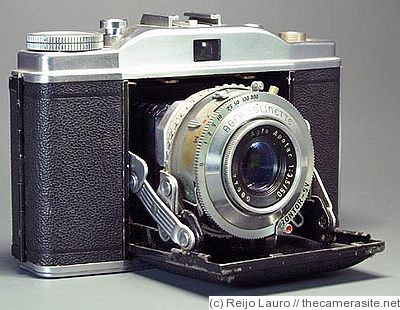Don't forget to update your personal camera inventory
AGFA: Solinette II
CollectiBlend Average Index
We don't have enough information to provide an accurate price for this camera, so this is the suggestion based on what we have. | ||||||||||||
| Camera rarity | ||||||||||||
Searching eBay listings: 
1952-1955. 35mm, folding camera. Also known as "Ansco Regent".

Camera featured in these collections: jsderie seisneves![]() cjcaudry bill339
cjcaudry bill339![]() fricicchia
fricicchia![]() Blesaster Arndt Hanniesko Zoloto
Blesaster Arndt Hanniesko Zoloto![]() Boender
Boender
converted and inflation-adjusted prices:
| Condition | Price | |||
| 2003-02-28 | $49 | |||
| 2002-01-01 | ~$17 | |||
Post a reply
Name Lens Shutter
Solinette Compur RMXV Solinar f/3.5/50mm Compur RMXV
Solinette Prontor SV Apotar f/3.5/50mm Prontor SV
Solinette Prontor SVS Apotar f/3.5/50mm Prontor SVS
Solinette Compur RMX Solinar f/3.5/45mm Synchro-Compur
Solinette USA Color Apotar f/3.5/45mm Prontor SVS
Solinette II Solinar Solinar f/3.5/50mm Synchro-Compur
Solinette II Prontor SVS Solinar f/3.5/50mm Prontor-SVS
Solinette II Apotar Apotar f/3.5/50mm Prontor SV
Agfa made this folding 35mm viewfinder camera between 1952 and 1955. The styling echos the medium-format Agfa Isolette cameras. The Solinette is a horizontal folder, i.e. the bed drops downwards on struts with the camera held horizontally, distinguishing it from the otherwise somewhat similar Kodak Retina. The top plate is almost symmetrical, with matching advance and rewind knobs, and the shutter release button on the right matching the bed release on the left. The shutter is cocked manually. The release button is threaded for a cable release. There is a double-exposure prevention interlock that releases the shutter when the film pin wheel turn during frame advance and it has no override control. The shutter is synchronized for flash, with a PC socket on top of the shutter unit, and a cold shoe on the top plate. The lens focuses to 3½ feet; focusing is by movement of the whole lens and shutter, with a focus ring behind the lens. There is a mechanical frame counter in a window in the middle of the top plate, in front of the accessory shoe. This must be set manually when a new role of film is loaded; the counter is advanced to 'A' by pressing the button on the back of the top housing (the button itself is released by a sliding control on the other side). The camera back is then closed and you advanced the counter to frame 1 after winding the film normally till it stops. The same frame counter button serves as the rewind release. On some examples, there is a film-type reminder dial in the rewind knob. There were two versions of this camera: the Solinette and Solinette II, and the latter is far more common. There were also several lens and shutter variations, as shown in the table above.
Solinette Compur RMXV Solinar f/3.5/50mm Compur RMXV
Solinette Prontor SV Apotar f/3.5/50mm Prontor SV
Solinette Prontor SVS Apotar f/3.5/50mm Prontor SVS
Solinette Compur RMX Solinar f/3.5/45mm Synchro-Compur
Solinette USA Color Apotar f/3.5/45mm Prontor SVS
Solinette II Solinar Solinar f/3.5/50mm Synchro-Compur
Solinette II Prontor SVS Solinar f/3.5/50mm Prontor-SVS
Solinette II Apotar Apotar f/3.5/50mm Prontor SV
Agfa made this folding 35mm viewfinder camera between 1952 and 1955. The styling echos the medium-format Agfa Isolette cameras. The Solinette is a horizontal folder, i.e. the bed drops downwards on struts with the camera held horizontally, distinguishing it from the otherwise somewhat similar Kodak Retina. The top plate is almost symmetrical, with matching advance and rewind knobs, and the shutter release button on the right matching the bed release on the left. The shutter is cocked manually. The release button is threaded for a cable release. There is a double-exposure prevention interlock that releases the shutter when the film pin wheel turn during frame advance and it has no override control. The shutter is synchronized for flash, with a PC socket on top of the shutter unit, and a cold shoe on the top plate. The lens focuses to 3½ feet; focusing is by movement of the whole lens and shutter, with a focus ring behind the lens. There is a mechanical frame counter in a window in the middle of the top plate, in front of the accessory shoe. This must be set manually when a new role of film is loaded; the counter is advanced to 'A' by pressing the button on the back of the top housing (the button itself is released by a sliding control on the other side). The camera back is then closed and you advanced the counter to frame 1 after winding the film normally till it stops. The same frame counter button serves as the rewind release. On some examples, there is a film-type reminder dial in the rewind knob. There were two versions of this camera: the Solinette and Solinette II, and the latter is far more common. There were also several lens and shutter variations, as shown in the table above.
Searching eBay listings: 
Searching other listings: 
Icons legend: